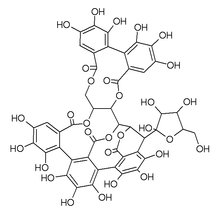
| |
| Identifiers | |
|---|---|
| CAS Number | |
| 3D model (JSmol) | |
| PubChem CID | |
| CompTox Dashboard (EPA) | |
SMILES
| |
| Properties | |
| Chemical formula | C46H34O30 |
| Molar mass | 1066.748 g·mol |
| Except where otherwise noted, data are given for materials in their standard state (at 25 °C , 100 kPa).
| |
Grandinin is an ellagitannin. It can be found in Melaleuca quinquenervia leaves and in oaks species like the North American white oak (Quercus alba) and European red oak (Quercus robur). It shows antioxydant activity. It is an astringent compound. It is also found in wine, red or white, aged in oak barrels.
It is a castalagin glycoside by binding of the pentose lyxose. It contains a nonahydroxytriphenic acid moiety.
It suppresses the phosphorylation of the epidermal growth factor receptor in human colon carcinoma cells.
See also
References
- ^ Moharram, F. A.; Marzouk, M. S.; El-Toumy, S. A. A.; Ahmed, A. A. E.; Aboutabl, E. A. (2003). "Polyphenols of Melaleuca quinquenervia leaves – pharmacological studies of grandinin". Phytotherapy Research. 17 (7): 767–773. doi:10.1002/ptr.1214. PMID 12916075.
- Mämmelä, P.; Savolainen, H.; Lindroos, L.; Kangas, J.; Vartiainen, T. (2000). "Analysis of oak tannins by liquid chromatography-electrospray ionisation mass spectrometry". Journal of Chromatography A. 891 (1): 75–83. doi:10.1016/S0021-9673(00)00624-5. PMID 10999626.
- ^ Hofmann, T.; Glabasnia, A.; Schwarz, B.; Wisman, K. N.; Gangwer, K. A.; Hagerman, A. E. (2006). "Protein Binding and Astringent Taste of a Polymeric Procyanidin, 1,2,3,4,6-Penta-O-galloyl-β-d-glucopyranose, Castalagin, and Grandinin". Journal of Agricultural and Food Chemistry. 54 (25): 9503–9509. doi:10.1021/jf062272c. PMC 2597504. PMID 17147439.
- García-Estévez, I.; Escribano-Bailón, M. T.; Rivas-Gonzalo, J. N. C.; Alcalde-Eon, C. (2010). "Development of a fractionation method for the detection and identification of oak ellagitannins in red wines". Analytica Chimica Acta. 660 (1–2): 171–176. Bibcode:2010AcAC..660..171G. doi:10.1016/j.aca.2009.10.020. hdl:10366/141103. PMID 20103159.
- Marinov, M. G.; Dimitrova, E. D.; Puech, J. -L. (1997). "Kinetics of ellagitannin extraction from oak wood using white wine". Journal of Wine Research. 8: 29–40. doi:10.1080/09571269708718095.
- ^ Fridrich, D.; Glabasnia, A.; Fritz, J.; Esselen, M.; Pahlke, G.; Hofmann, T.; Marko, D. (2008). "Oak Ellagitannins Suppress the Phosphorylation of the Epidermal Growth Factor Receptor in Human Colon Carcinoma Cells". Journal of Agricultural and Food Chemistry. 56 (9): 3010–3015. doi:10.1021/jf073427z. PMID 18419129., INIST 20325664
| Growth factor receptor modulators | |||||||||||
|---|---|---|---|---|---|---|---|---|---|---|---|
| Angiopoietin |
| ||||||||||
| CNTF |
| ||||||||||
| EGF (ErbB) |
| ||||||||||
| FGF |
| ||||||||||
| HGF (c-Met) |
| ||||||||||
| IGF |
| ||||||||||
| LNGF (p75) |
| ||||||||||
| PDGF |
| ||||||||||
| RET (GFL) |
| ||||||||||
| SCF (c-Kit) |
| ||||||||||
| TGFβ |
| ||||||||||
| Trk |
| ||||||||||
| VEGF |
| ||||||||||
| Others |
| ||||||||||